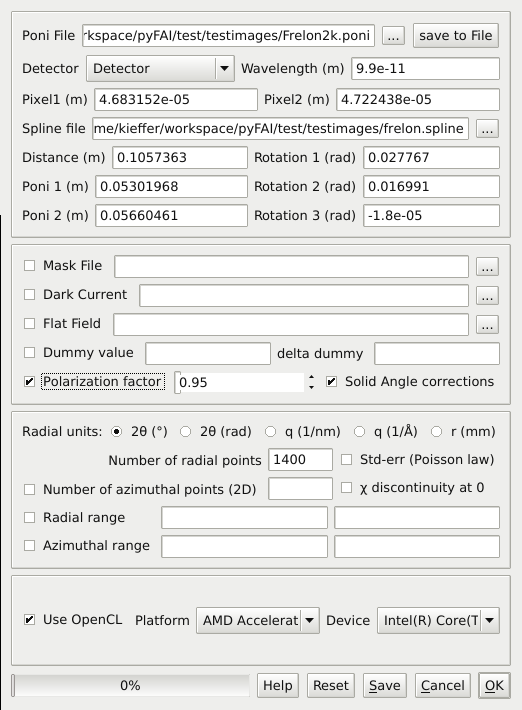Integration tool: pyFAI-integrate¶
Purpose¶
PyFAI-integrate is a graphical interface (based on Python/Qt4) to perform azimuthal integration on a set of files. It exposes most of the important options available within pyFAI and allows you to select a GPU (or an openCL platform) to perform the calculation on.

Usage¶
pyFAI-integrate [options] file1.edf file2.edf ...
Options:¶
--version show program’s version number and exit -h, --help show help message and exit -v, --verbose switch to verbose/debug mode -o OUTPUT, --output=OUTPUT Directory or file where to store the output data
Tips & Tricks:¶
PyFAI-integrate saves all parameters in a .azimint.json (hidden) file. This JSON file is an ascii file which can be edited and used to configure online data analysis using the LImA plugin of pyFAI.
Nota: there is bug in debian6 making the GUI crash (to be fixed inside pyqt) http://bugs.debian.org/cgi-bin/bugreport.cgi?bug=697348
Example:¶
$ pyFAI-integrate --help
usage: pyFAI-integrate [options] file1.edf file2.edf ...
PyFAI-integrate is a graphical interface (based on Python/Qt4) to perform
azimuthal integration on a set of files. It exposes most of the important
options available within pyFAI and allows you to select a GPU (or an openCL
platform) to perform the calculation on.
positional arguments:
FILE Files to be integrated
optional arguments:
-h, --help show this help message and exit
-V, --version show program's version number and exit
-v, --verbose switch to verbose/debug mode
-o OUTPUT, --output OUTPUT
Directory or file where to store the output data
-f FORMAT, --format FORMAT
output data format (can be HDF5)
-s SLOW, --slow-motor SLOW
Dimension of the scan on the slow direction (makes
sense only with HDF5)
-r RAPID, --fast-motor RAPID
Dimension of the scan on the fast direction (makes
sense only with HDF5)
--no-gui Process the dataset without showing the user
interface.
-j JSON, --json JSON Configuration file containing the processing to be
done
PyFAI-integrate saves all parameters in a .azimint.json (hidden) file. This
JSON file is an ascii file which can be edited and used to configure online
data analysis using the LImA plugin of pyFAI. Nota: there is bug in debian6
making the GUI crash (to be fixed inside pyqt) http://bugs.debian.org/cgi-
bin/bugreport.cgi?bug=697348